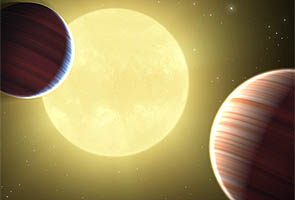- Home
- Others
- Others News
- Telescope detects possible Earth size planet
Telescope detects possible Earth-size planet
By Kenneth Chang, New York Times | Updated: 5 June 2012 02:24 IST

Click Here to Add Gadgets360 As A Trusted Source

Advertisement
Scientists working with NASA's Kepler satellite reported on Thursday that they might have spotted a planet just 1.5 times the diameter of Earth around a Sun-like star 2,000 light-years away.
"We're still in the process of confirming this candidate is a planet," said Matthew Holman, of the Harvard-Smithsonian Center for Astrophysics, at a NASA-sponsored news conference on Thursday. Dr. Holman is the lead author of an article describing the discoveries that the journal Science published on its Web site.
This is the first announcement of a candidate Earth-size planet by the Kepler mission, which in March 2009 launched a one-ton spacecraft to search for planets like ours that just might harbor life. The planet was among more than 700 candidate planets that the team announced in June. If it is made of similar stuff as Earth, its mass would be three to four times as much.
Astronomers are quickly closing in on Earth-size planets elsewhere in the galaxy as they find planetary systems that look more and more like our solar system.
"This represents a significant step toward Kepler's goal of determining the frequency of Earth-size planets in the habitable zones of Sun-like stars," Dr. Holman said. Earth-size planets in orbits that are not too hot or too cold are considered the most likely places to look for life elsewhere in the universe.
The Kepler team also observed, more definitively, two giant, Saturn-size gas planets around the same star, known as Kepler-9.
On Tuesday, a European team reported what may be a smaller planet, with mass as little as 1.4 times that of Earth, around a star 127 light-years away.
In the 15 years since the first extrasolar planet orbiting a Sun-like star was discovered, astronomers have found close to 500 more. The first were huge gas planets -- composed mostly of hydrogen, similar to Jupiter -- that orbited extremely close to their stars.
But as detection methods improved, astronomers began to find planets closer in size to Earth and planetary systems that contain nearly as many planets as our solar system.
The Earth-size planet seen by the European astronomers appears to be one of seven circling the star, HD 10180, located in the constellation Hydrus. Christophe Lovis of the University of Geneva, who led the observations, said the group was certain about the existence of five of the planets, all about the mass of Neptune, but squeezed into orbits closer to the star than Mars is to the Sun.
They are less certain about the smallest planet. "For this one, we have about 1 percent false alarm possibility," Dr. Lovis said. "For us, 99 percent is just not enough to be completely sure."
The team also tentatively detected a larger, Saturn-size planet farther from the star.
Neither of the slightly-bigger-than-Earth planets is Earth-like or has much chance for anything to live there. Both have orbits very close to their stars that would sear the surfaces. The small Kepler-9 planet completes an orbit in just over a day and a half at a distance of 2.5 million miles from the star. The small HD 10180 planet is even closer and faster, less than two million miles from the star and completing an orbit in about 28 hours. Earth, by contrast, is 93 million miles from the Sun, and its orbit takes 365 days to complete.
"If one particular word can describe planetary systems today, it's 'diverse,' " said Douglas N. C. Lin, a professor of astronomy and astrophysics at the University of California, Santa Cruz, who was not involved with either team. "Planets are common, and their properties are diverse."
To date, most of the extrasolar planets have been found using the technique of the European team, by looking for wobbles in the wavelength of light from the star caused by the back-and-forth gravitational tugging of unseen planets. The discovery of the HD 10180 planets results from six years of observations at the European Southern Observatory's 3.6-meter telescope in Chile.
If the orbits of planets are not edge-on to observers on Earth, the technique underestimates the masses of the planets. Dr. Lovis said that for HD 10180, computer simulations show that for the orbits to be stable, the planets cannot be more than three times the minimum masses calculated.
Some planets have been detected when a star dims momentarily as a planet passes in front. The duration of the dip tells the size of the planet, and the time between the light dips tells the length of the planet's orbit.
The Kepler mission takes that notion and applies it on a grand scale by staring at a patch of sky in the Cygnus and Lyra constellations to continuously observe the brightness of 156,000 stars.
A Kepler scientist, Dimitar Sasselov of the Harvard-Smithsonian Center for Astrophysics, created a stir last month when he said in a lecture that Kepler had discovered many Earth-like planets. He later said that the candidates had not been confirmed and that he should have said Earth-size, not Earth-like. The Kepler instruments cannot measure atmospheric or geological properties.
So far, the astronomers have seven months of data, and Kepler is scheduled to operate for 3.5 years. Astronomers will soon be able to identify smaller planets farther out, including truly Earth-size planets in orbits that would impart Earth-like temperatures.
"Come back in a couple of years," said William J. Borucki, Kepler's principal investigator, "and we'll give you an answer."
"We're still in the process of confirming this candidate is a planet," said Matthew Holman, of the Harvard-Smithsonian Center for Astrophysics, at a NASA-sponsored news conference on Thursday. Dr. Holman is the lead author of an article describing the discoveries that the journal Science published on its Web site.
This is the first announcement of a candidate Earth-size planet by the Kepler mission, which in March 2009 launched a one-ton spacecraft to search for planets like ours that just might harbor life. The planet was among more than 700 candidate planets that the team announced in June. If it is made of similar stuff as Earth, its mass would be three to four times as much.
Astronomers are quickly closing in on Earth-size planets elsewhere in the galaxy as they find planetary systems that look more and more like our solar system.
"This represents a significant step toward Kepler's goal of determining the frequency of Earth-size planets in the habitable zones of Sun-like stars," Dr. Holman said. Earth-size planets in orbits that are not too hot or too cold are considered the most likely places to look for life elsewhere in the universe.
The Kepler team also observed, more definitively, two giant, Saturn-size gas planets around the same star, known as Kepler-9.
On Tuesday, a European team reported what may be a smaller planet, with mass as little as 1.4 times that of Earth, around a star 127 light-years away.
In the 15 years since the first extrasolar planet orbiting a Sun-like star was discovered, astronomers have found close to 500 more. The first were huge gas planets -- composed mostly of hydrogen, similar to Jupiter -- that orbited extremely close to their stars.
But as detection methods improved, astronomers began to find planets closer in size to Earth and planetary systems that contain nearly as many planets as our solar system.
The Earth-size planet seen by the European astronomers appears to be one of seven circling the star, HD 10180, located in the constellation Hydrus. Christophe Lovis of the University of Geneva, who led the observations, said the group was certain about the existence of five of the planets, all about the mass of Neptune, but squeezed into orbits closer to the star than Mars is to the Sun.
They are less certain about the smallest planet. "For this one, we have about 1 percent false alarm possibility," Dr. Lovis said. "For us, 99 percent is just not enough to be completely sure."
The team also tentatively detected a larger, Saturn-size planet farther from the star.
Neither of the slightly-bigger-than-Earth planets is Earth-like or has much chance for anything to live there. Both have orbits very close to their stars that would sear the surfaces. The small Kepler-9 planet completes an orbit in just over a day and a half at a distance of 2.5 million miles from the star. The small HD 10180 planet is even closer and faster, less than two million miles from the star and completing an orbit in about 28 hours. Earth, by contrast, is 93 million miles from the Sun, and its orbit takes 365 days to complete.
"If one particular word can describe planetary systems today, it's 'diverse,' " said Douglas N. C. Lin, a professor of astronomy and astrophysics at the University of California, Santa Cruz, who was not involved with either team. "Planets are common, and their properties are diverse."
To date, most of the extrasolar planets have been found using the technique of the European team, by looking for wobbles in the wavelength of light from the star caused by the back-and-forth gravitational tugging of unseen planets. The discovery of the HD 10180 planets results from six years of observations at the European Southern Observatory's 3.6-meter telescope in Chile.
If the orbits of planets are not edge-on to observers on Earth, the technique underestimates the masses of the planets. Dr. Lovis said that for HD 10180, computer simulations show that for the orbits to be stable, the planets cannot be more than three times the minimum masses calculated.
Some planets have been detected when a star dims momentarily as a planet passes in front. The duration of the dip tells the size of the planet, and the time between the light dips tells the length of the planet's orbit.
The Kepler mission takes that notion and applies it on a grand scale by staring at a patch of sky in the Cygnus and Lyra constellations to continuously observe the brightness of 156,000 stars.
A Kepler scientist, Dimitar Sasselov of the Harvard-Smithsonian Center for Astrophysics, created a stir last month when he said in a lecture that Kepler had discovered many Earth-like planets. He later said that the candidates had not been confirmed and that he should have said Earth-size, not Earth-like. The Kepler instruments cannot measure atmospheric or geological properties.
So far, the astronomers have seven months of data, and Kepler is scheduled to operate for 3.5 years. Astronomers will soon be able to identify smaller planets farther out, including truly Earth-size planets in orbits that would impart Earth-like temperatures.
"Come back in a couple of years," said William J. Borucki, Kepler's principal investigator, "and we'll give you an answer."
Comments
Catch the latest from the Consumer Electronics Show on Gadgets 360, at our CES 2026 hub.
Related Stories
Popular on Gadgets
- Samsung Galaxy Unpacked 2025
- ChatGPT
- Redmi Note 14 Pro+
- iPhone 16
- Apple Vision Pro
- Oneplus 12
- OnePlus Nord CE 3 Lite 5G
- iPhone 13
- Xiaomi 14 Pro
- Oppo Find N3
- Tecno Spark Go (2023)
- Realme V30
- Best Phones Under 25000
- Samsung Galaxy S24 Series
- Cryptocurrency
- iQoo 12
- Samsung Galaxy S24 Ultra
- Giottus
- Samsung Galaxy Z Flip 5
- Apple 'Scary Fast'
- Housefull 5
- GoPro Hero 12 Black Review
- Invincible Season 2
- JioGlass
- HD Ready TV
- Laptop Under 50000
- Smartwatch Under 10000
- Latest Mobile Phones
- Compare Phones
Latest Gadgets
- Honor Win RT
- Honor Win
- Xiaomi 17 Ultra Leica Edition
- Xiaomi 17 Ultra
- Huawei Nova 15
- Huawei Nova 15 Pro
- Huawei Nova 15 Ultra
- OnePlus 15R
- Asus ProArt P16
- MacBook Pro 14-inch (M5, 2025)
- OPPO Pad Air 5
- Huawei MatePad 11.5 (2026)
- Xiaomi Watch 5
- Huawei Watch 10th Anniversary Edition
- Acerpure Nitro Z Series 100-inch QLED TV
- Samsung 43 Inch LED Ultra HD (4K) Smart TV (UA43UE81AFULXL)
- Asus ROG Ally
- Nintendo Switch Lite
- Haier 1.6 Ton 5 Star Inverter Split AC (HSU19G-MZAID5BN-INV)
- Haier 1.6 Ton 5 Star Inverter Split AC (HSU19G-MZAIM5BN-INV)
© Copyright Red Pixels Ventures Limited 2025. All rights reserved.

















